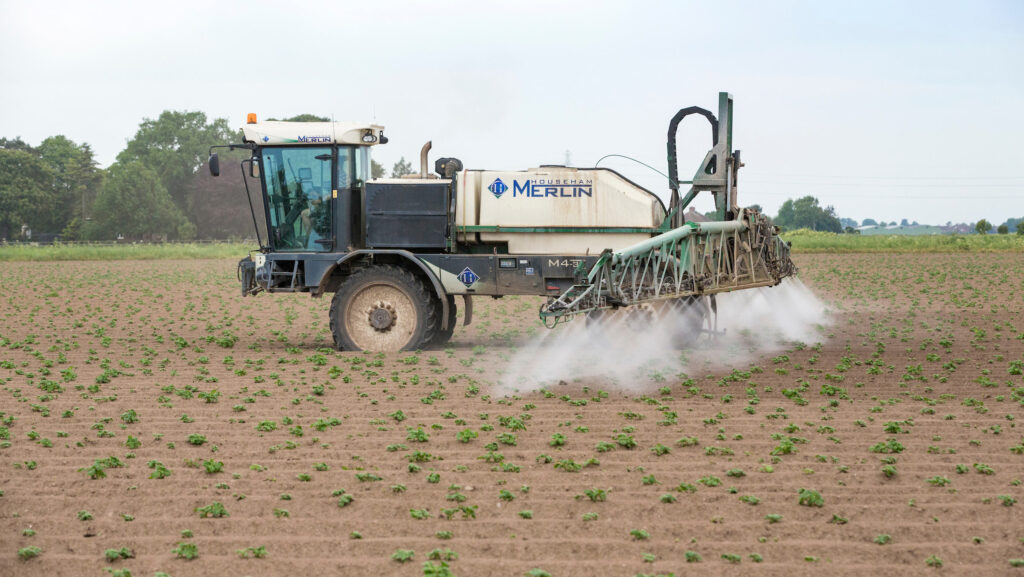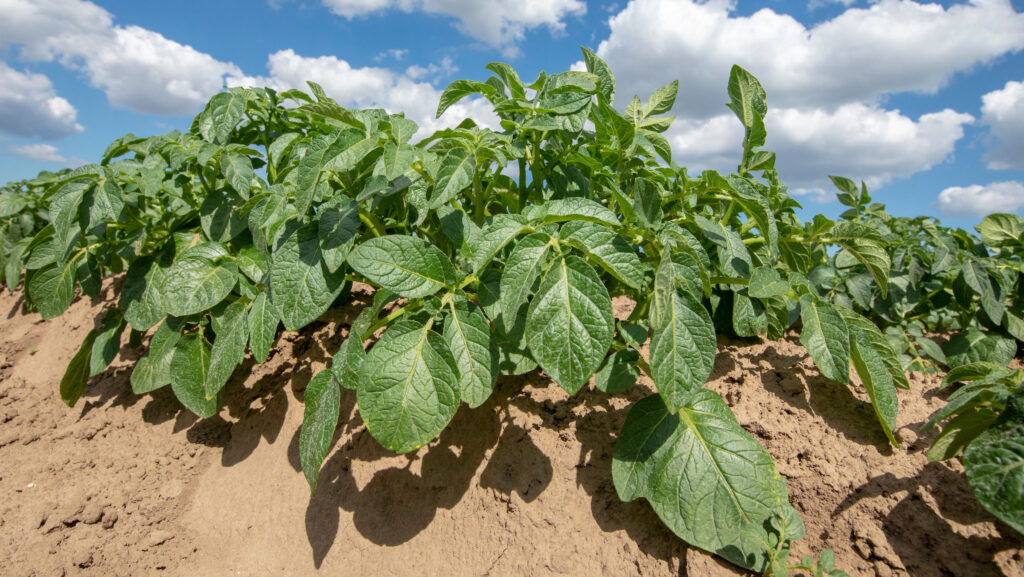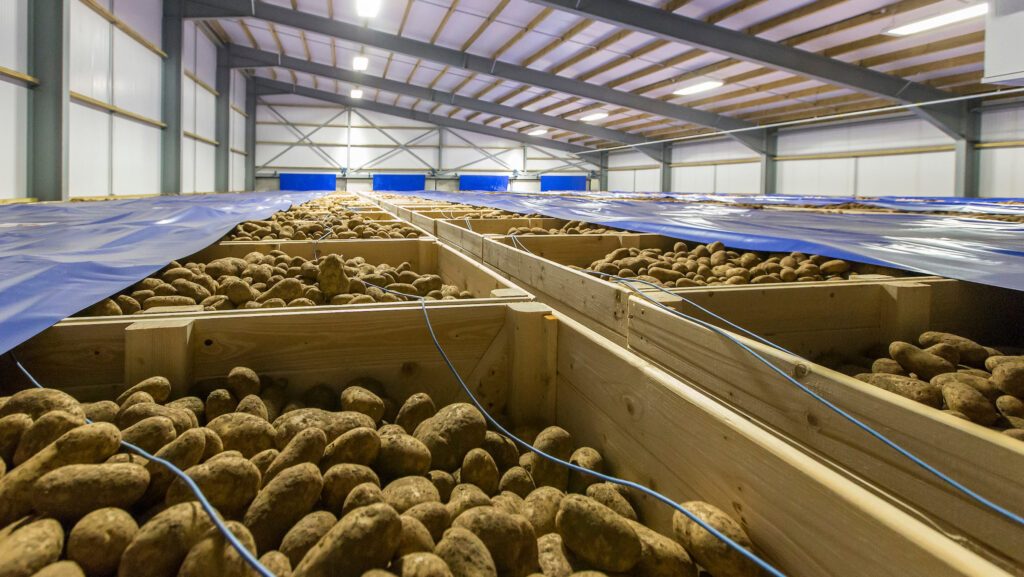Gene-edited potatoes edge closer to tackling sector challenges
 © GNP
© GNP Genetic engineering of crops like potato is essential for grower survival, according to one expert, but experience in the US suggests that everyone – from grower to processor to consumer – needs to benefit before barriers to wide-scale adoption are fully lifted.
See also: Scientists plan to use gene-editing tech to transform potato sector
There is no shortage of pessimism surrounding the potato industry, as the list of challenges continue to stack up, but questions remain over the future role of gene editing and genetic modification technology in the potato sector.
Non-growing challenges caused by volatility in global markets has ratcheted up costs and the list of critical growing challenges lengthens as crop protection options dwindle.
Critical challenges
Growers are struck with high virus disease levels in seed, a rapidly evolving potato late blight population, increasing wireworm numbers, and ever-present plant parasitic nematodes.
Fluctuating weather patterns with intense rainfall are also reducing yield and quality, while exacerbating disease pressure.
This is a major concern to Cambridge University Potato Grower’s Research Association (Cupgra) president Tina Barsby, who believes the viability of potato production cannot be maintained without precision breeding tools such as Crispr-Cas-9.
“I’m most afraid that if we do not adopt this technology, then it will become increasingly difficult for our farmers to survive in a world where we are actively trying to reduce fertilisers and pesticides and even more, get to net zero,” she says.
So how close are potato growers to benefiting from genetic engineering (GE) in the UK and Europe?
The Genetic Technology (Precision Breeding) Act 2023 reached royal ascent in March last year, paving the way to a more science-based and streamlined regulatory system that will help stimulate research and innovation in precision breeding.
This is in contrast to genetically modified organisms (GMOs), which will remain strictly regulated for the foreseeable future (see GE vs GMO).
“[The Act] follows the logic that gene edited organisms are no different to those produced by conventional breeding. It’s just a way of speeding [the selection process] up.
“Thirty-eight statutory requirements need to be met to enact the bill, which could take 18 months to two years from the passage of the bill,” explains Tina.
However, in the meantime it will be much easier for scientists to carry out GE field trials, with a simpler notification process than with GM.

© GNP
European shift
Within the European Union, there has been a subtle shift in tone after the European Court of Justice declared last February plants derived from in vitro mutagenesis methods like Crispr-Cas9 fall outside EU rules on GMOs.
This strengthens the case for deregulation of GE in the EU, but has caused a backlash among the organic movement over non-GE crop isolation concerns.
There is also the EU’s precautionary principle, which encourages regulatory action to exclude environmental or consumer risks, even if there is insufficient evidence as to the magnitude of risks.
However, other organic producers believe that GE would be welcome and will help the wider food system reduce its reliance on synthetic inputs.
“A new technology is assumed to be guilty until it can be proven innocent, to a safety standard that’s not defined, and it permits regulators to ignore overwhelming evidence of a product or a technology’s safety elsewhere [such as the USA],” says Tina.
“So, to me, if the precautionary principle is invoked in Europe, it is going to be a real problem for any new technology [like gene editing].”
Despite mixed messages across the Channel, the European Parliament is trying to move the debate forward, with agricultural and environmental committees considering and voting on an imminent GE report.
The outcome is tipped to be positive, as quickly bringing in GE crop varieties with improved disease resistance or better nitrogen use efficiency will help the EU meet targets set out in its Green Deal and Farm to Fork strategy.
Open door for potatoes
Craig Richael, director of research and development for Simplot Plant Sciences says: “The door has never been more open to GE in the UK and now is the time to push forward.”
This multinational agricultural company is credited with inventing the frozen French fry and processes potatoes on every continent, except Europe and Antarctica.
It has invested heavily in potato genetics, using GMO technology to produce its innate potato range that aims to improve sustainability of established potato varieties and reduce food waste.
The first generation – using Russet Burbank as a starting point – has the gene responsible for polyphenol oxidase enzyme production silenced to reduce bruising risk and slow browning when the product is peeled.
The variety also has reduced asparagine, which results in half the acrylamide accumulation during the cooking process and is marketed under the White Russet brand in supermarkets and restaurants.
Second generation work incorporated traits that suppress cold-induced sweetening, meaning tubers destined for processing can be cold-stored for longer, without compromising fry colour.
Third and fourth generation varieties have focussed on disease challenges, adding late blight and potato virus Y resistance traits to reduce reliance on plant protection products.

© GNP
Transparency is key
Transparency is key for Simplot when launching its biotech products, even before legislation forced food companies to clearly label all GMO-derived products.
This included a QR code linking consumers to information about the technology and benefits that the potatoes bring for sustainability.
“We did some research to discover that consumers like to be informed. They don’t want to feel duped, so we found it advantageous to have information on the package that describes what we did,” explains Craig.
The company had little negative feedback, with the perception of its GMO varieties positive, particularly in the fresh market.
However, no more than 2,000ha of any one Innate variety have been grown in the US so far which Craig attributes to three factors:
- Fast-food giants see GMOs as a threat to their reputation and pulled the plug in the 1990s after a backlash against the launch of Monsanto’s original GMO potato
- It is a threat to international trade, with some countries unwilling to import GMOs, including potatoes
- Biotech varieties need to provide value throughout the supply chain and arguably, until recently the products haven’t always done that.
Craig is now optimistic these barriers will ease as the focus of biotech companies switches from GMO to GE, with GE now considered the same as conventional breeding in the eyes of US and UK regulators.
This is reflected in a recent consumer survey commissioned by Simplot, which found 80% of respondents were “more” or “slightly more positive” about biotech now than previously.
Yield increase
Along with a shift in attitude, processors are benefiting from GE potatoes, taking advantage of a trend towards “baby bakers” derived from old varieties like Bintje.
The variety produces low tuber numbers – typically 12-15/plant – and needs to be planted at high densities to meet the size demands of this market, compromising yield.
With a single edit, knocking out one gene, Bintje’s stolons can be encouraged to branch more, resulting in 48 tubers/plant, significantly increasing marketable yield.
This can be done to any potato variety, opening up the possibility of engineering any established cultivar in a way that adds value at both ends of the supply chain.
Combined with beneficial agronomic traits like disease and pest resistance and better nutrient and water use efficiency, along with consumer benefits like better nutritional value, uptake could be rapid.
Craig encourages the UK potato industry to get started on developing similar GE products here as resistance dwindles, as it has in the US.
Asked if GM technology would be defunct with the acceleration GE, Craig was adamant it would still have a place and could even be helped by GE.
Simplot Plant Sciences is evolving its research work in favour of Crispr because it is a simpler, cheaper, and faster path to market from a regulatory standpoint, but GM can engineer traits GE can’t.
“We still see a place for genetic modification and believe that actually, gene editing will open the door for acceptance of GMO.”
Genetic-engineered potato products could soon be seen in the UK
Much of the biotech work in the UK has used genetic modification (GM) technology.
For example, the Sainsbury’s Laboratory modified the Maris Piper, Charlotte, and Hermes varieties with traits for blight resistance, virus Y resistance, less bruising and less cold-induced sweetening.
However, genetically modified organisms (GMOs) are likely to remain heavily regulated in the short-to-medium term, with gene-edited products leading the way. Here are some examples.
Vitamin D fortified potato
Vitamin D is essential for good physical health, and deficiency is a concern in the UK, as people don’t produce enough themselves from UV radiation between October and March.
Researchers at the John Innes centre have used Crispr-Cas9 to engineer a tomato plant to produce more vitamin D3, particularly in the leaves when exposed to UV light.
As well as elevated levels in the fruit, the very high level that accumulates in the foliage means production waste could be used to make vitamin D3 supplements.
These would be more beneficial than the current vitamin D2 supplements made from other plant sources.
As tomatoes and potatoes are in the same family, it’s thought the same edit could be made to the potato and potentially lead to using haulm in the production of supplements, providing growers more value from their crops.
The vitamin D3-fortified tomato should be put to the Food Standards Agency for assessment within 12 months and could be the first gene-edited crop commercialised in England under The Genetic Technology (Precision Breeding) Act 2023.
Increased photosynthetic ability
The EU-funded PhotoBoost project is looking to improve the photosynthetic performance of potato using a combination of genetic engineering and modification tools.
Results suggest photosynthesis rates could be increased by 20%-25%, which could increase production efficiency and yield.
A factor that could slow the commercial launch of any lines born out of the project within the EU and UK is the use of GM, as GMOs are still heavily regulated both sides of the channel.
That said, one of the project’s scientists suggests varieties could be ready as early as 2025.
Genetic modification vs genetic engineering
Genetic modification technology essentially inserts a new combination of genetic material from related or unrelated organisms into the DNA of the organism for which modification is sought.
Genetic engineering tools like Crispr-Cas9 are used to generate precisely mutations to an organism’s existing genetic make-up.
These could have occurred naturally in traditional breeding programmes, but can take many years to identify and select for crossing into commercial lines.
Combined with genome maps of target crops, scientists can target edits to specific locations and dramatically shorten the time taken to find desired traits.
Cambridge University Potato Growers Research Association
This article is based on presentations given at Cupgra’s 34th Annual Cambridge Potato Conference in December 2023 at Robinson College, Cambridge.
Cupgra (Cambridge University Potato Growers Research Association) is a membership body that promotes the interchange of scientific research and field practice for innovative, sound commercial production of potatoes.
Members include growers, agronomists, packers, processors and other industry stakeholders in the supply chain who value independent, high-quality research.

